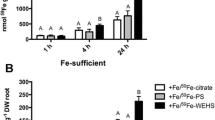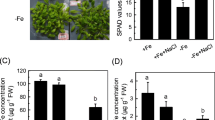Abstract
The influence of Fe nutrition on the distribution of the heavy metals Fe, Mn, Zn, and Cu and of the heavy metal chelators nicotianamine (NA) and citrate in 6 different shoot and 3 different root parts and in xylem exudate of a NA-containing tomato wild type and its NA-less mutant was investigated. Under the same Fe supply the mutant showed higher Fe, Mn, and Zn concentrations in all organs investigated, with exception of the shoot apex. The Cu concentration in the mutant was only in root parts higher than in the wild type but much lower in leaves. Analyses of xylem exudate showed that Fe, Mn, and Zn were readily translocated by both genotypes from the roots to the shoot at all levels of Fe supply, whereas in the absence of NA, Cu was only poorly transported. Citrate as main Fe chelator in the xylem was present in high concentrations in xylem exudate of the wild type under low Fe supply but in the mutant also at 10 μM FeEDTA. NA occurred in xylem exudate of the wild type in concentrations high enough to chelate heavy metal ions.
Generally, high Fe supply induced a decrease of Mn, Cu, and Zn concentrations in all organs of the wild type whereas high concentrations were observed in most cases under Fe deficiency. A positive correlation between Fe supply and NA concentration existed only in the shoot apex and in the xylem exudate of wild type plants. From the correlation between Cu and NA translocation and from the high stability constant of the NA-Cu-complex (log K=18.6) it is concluded that NA is a chelator for Cu in the xylem, whereas the translocation of Fe, Mn, and Zn is independent of NA.
Similar content being viewed by others
Abbreviations
- EDTA:
-
ethylene-diaminetetraacetate
- NA:
-
nicotianamine-(2S:3′S:3″S)-N-[N-(3amino-3-carboxypropyl)-3-amino-3-carboxypropyl]-azetidine-2-carboxylic acid
References
Adler K and Scholz G 1986 Die Chloroplastenstrukturen der Mutante chloronerva von Lycopersicon esculentum Mill. im Mutantenstatus und nach Normalisierung mit Nicotianamin. Kulturpflanze 34, 185–194.
Arnon D I 1949 Copper enzymes in isolated chloroplasts. Polyphenoloxidase in Beta vulgaris. Plant Physiol 24, 1–15.
Beneš I, Schreiber K, Ripperger H and Kircheiss A 1983 Metal complex formation by nicotianamine, a possible phytosiderophore. Experientia 39, 261–262.
Bergmann W 1988 Ernährungsstörungen bei Kulturpflanzen. Entstehung, visuelle und analytische Diagnose. Gustav Fischer Verlag, Jena, Germany. 762 p.
Boehringer 1986 UV-method for the determination of citric acid in food stuffs and other materials. Mannheim.
Cakmak I and Horst W J 1991 Effect of aluminium on lipid peroxidation, superoxide dismutase, catalase, and peroxidase activities in root tips of soybean (Glycine max). Physiol. Plant 83, 463–468.
Cataldo D A, Mc Fadden K M, Garland T R and Wildung R E 1988 Organic constituents and complexation of nickel (III), iron (III), cadmium (II), and plutonium (IV) in soybean xylem exudates. Plant Physiol. 86, 734–739.
Foy C D, Chaney R L and White M C 1978 The physiology of metal toxicity in plants. Annu. Rev. Plant Physiol. 29, 511–566.
Graham R D 1981 Absorption of copper by plant roots. In Copper in Soils and Plants. Eds. J F Loneragan, A D Robson and R D Graham. pp 141–163. Academic Press, New York, USA.
Jooste J H and DeBruyn J A 1979 The dual mechanism of iron absorption in bean root and leaf tissues. S. Afr. J. Bot. 45, 249–256.
Kochian L V 1991 Mechanisms of micronutrient uptake and translocation in plants. In Micronutrients in Agriculture. Eds. J J Mortvedt, F R Cox, M Shuman and R M Welch. pp 229–296. Soil Science Society of America, Inc. Madison, Wisconsin, USA.
Lichtenthaler H K and Wellburn A R 1983 Determination of total carotinoids and chlorophylls a and b of leaf extracts in different solvents. Biochem. Soc. Transact. 603, 591–592.
Pich A and Scholz G 1991 Nicotianamine and the distribution of iron into apoplast and symplast of tomato (Lycopersicon esculentum Mill.). II. Uptake of iron by protoplasts from the variety Bonner Beste and its nicotianamine-less mutant chloronerva and the compartmentation of iron in leaves. J. Exp. Bot. 42, 1517–1523.
Pich A and Scholz G 1993 The relationship between the activity of various iron-containing and iron-free enzymes and the presence of nicotianamine in tomato seedlings. Physiol. Plant. 88, 172–178.
Pich A, Scholz G and Seifert K 1991 Effect of nicotianamine on iron uptake and and citrate accumulation in two genotypes of tomato, Lycopersicon esculentum Mill. J. Plant Physiol. 137, 323–326.
Rudolph A and Scholz G 1972 Physiologische Untersuchungen an der Mutante chloronerva von Lycopersicon esculentum Mill. IV. Über eine Methode zur Bestimmung des “Normalisierungsfaktors” sowie über dessen Vorkommen im Pflanzenreich. Biochem. Physiol. Pflanz. 163, 156–168.
Scandalios J G 1993 Oxygen stress and superoxide dismutases. Plant Physiol. 101, 7–12.
Scholz G 1989 Effect of nicotianamine on iron-remobilisation in de-rooted tomato seedlings. Biol. Metals 2, 89–91.
Scholz G, Becker R, Stephan U W, Rudolph A and Pich A 1988 The regulation of iron uptake and possible functions of nicotianamine in higher plants. Biochem. Physiol. Pflanz. 183, 257–269.
Scholz G, Seifert K and Grün M 1987 The effect of nicotianamine on the uptake of Mn2+, Zn2+, Cu2+, Rb+ and PO4 3- by the tomato mutant chloronerva. Biochem. Physiol. Pflanz. 182, 189–194.
Stephan U W and Grün M 1989 Physiological disorders of the nicotianamine-auxotroph tomato mutant chloronerva at different levels of iron nutrition. II. Iron deficiency response and heavy metal metabolism. Biochem. Physiol. Pflanz. 185, 189–200.
Stephan U W and Rudolph A 1984 An improved and standardized method for extraction of nicotianamine from plant tissue. Biochem. Physiol. Pflanz. 179, 517–523.
Stephan U W and Scholz G 1990 Nicotianamine concentrations in iron sufficient and iron deficient sunflower and tomato roots. J. Plant Physiol. 136, 631–634.
Stephan U W, Scholz G and Rudolph A 1990 Distribution of nicotianamine, a presumed symplast iron transporter, in different organs of sunflower and of a tomato wild type and its mutant chloronerva. Biochem. Physiol. Pflanz. 186, 81–88.
Stephan U W, Schmidke I and Pich A 1994 Phloem translocation of Fe, Cu, Mn, and Zn in Ricinus seedlings in relation to the concentrations of nicotianamine, an endogenous chelator of divalent metal ions, in different seedling parts. Plant and Soil 165, 181–188.
Tiffin L O 1966 Iron translocation. II. Citrate/iron ratios in plant stem exudates. Plant Physiol. 41, 515–518.
Tiffin L O 1967 Translocation of manganese, iron, cobalt, and zinc in tomato. Plant. Physiol. 42, 1427–1432.
VanAssche F and Clijsters H 1990 Effects of metals on enzyme activity in plants. Plant, Cell Environ. 13, 195–206.
White M C, Baker F D, Chaney R L and Decker A M 1981 Metal comlexation in xylem fluid. II. Theoretical equilibrium model and computational computer program. Plant. Physiol. 67, 301–310.
Author information
Authors and Affiliations
Rights and permissions
About this article
Cite this article
Pich, A., Scholz, G. & Stephan, U.W. Iron-dependent changes of heavy metals, nicotianamine, and citrate in different plant organs and in the xylem exudate of two tomato genotypes. Nicotianamine as possible copper translocator. Plant Soil 165, 189–196 (1994). https://doi.org/10.1007/BF00008061
Issue Date:
DOI: https://doi.org/10.1007/BF00008061




